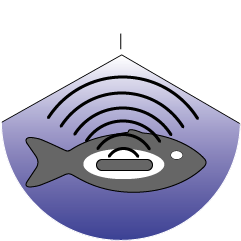- Acoustic fish tags are activated, detected and decoded by a multibeam sonar system.
- No expensive multi-receiver array is required. A single sonar head can geo-locate tags within > 120° field-of view and beyond 100 m in range.
- Transponder-type tags “wake-up” and only transmit ID (and sensor) codes when a multibeam sonar ping is detected. Very long battery-life (3+ years) given tag enters “sleep-mode” when outside of sonar sampling area.
- Ideal for assessing Eel and Sturgeon passage at hydro-electric facilities and cooling-water intakes.
- Mobile down-looking systems can be used to improve acoustic fish abundance estimates using size-stratified pseudo-mark/recapture models.
- Simultaneous tag detection and bottom substrate imaging (mosaics) to identify critical aquatic habitats.
- Rapid shoreline and shoal surveys to quickly identify potential spawning areas in lakes and rivers.
- Tag detection is at 500 kHz thus well suited for noisy environments such as around hydro-electric dam tail-outs, shipping channels and pumped water-intake facilities.
- Proven to readily detect and locate nearshore Cutthroat Trout in the nearshore area of a lake <1 m depth!
Typically, it is difficult to reliably detect tags using standard passive receiver arrays, in these very shallow water habitats. - Download our paper by Shuter et al. (2023)
Integrating hydroacoustic and telemetric surveys to estimate fish abundance: a new approach to an old problem
. - get more information about the transponder tag activator hardware..
- Stay updated with what’s new. Subscribe to our YouTube Channel to see what our sonar tag detection system can do for you.
Detecting Acoustic Fish Tags with Sonar - Overview
What is it?
How we do it.
Acoustic Transponder Tags
- The transponder-type acoustic fish tags are manufactured by Sonotronics (Tucson, Arizona), and are designed with a wide-band ceramic that can listen for a 200 kHz activation pulse.
- The tags can be either fixed externally or surgically implanted within the fish.
- Upon activation, the tag transmits a series of acoustic pulses that are coded to provide a unique identification pulse pattern.
- The tags are programmed to transmit only one ID pulse train for every activation pulse received with a duty cycle of up to 4 Hz.
- Once the tagged fish moves away from the activator beam swath, the tag returns to “sleep-mode” until another activator pulse is heard. The ability for these passive acoustic transponder tags to remain quiet for long periods of time between activation events gives them the potential of a very long battery life (3+ years) and allows the user to monitor individual fish over multiple years in habitats where fish may return on an annual basis (spawning tributaries and shoals, home ranges, feeding grounds, etc.).


Transponder Tag Activator
- The transponder tags are activated using the Kongsberg-Mesotech Ltd. “M3 Tag Activator System” that is synchronized and connected directly to operate with the Kongsberg-Mesotech Ltd. “M3” multi-mode multibeam echosounder system.
- The “M3 Tag Activator” sonar transducer generates a 200 kHz (>200 dB re 1uPa at 1 m) acoustic pulse with a swath width >140° x >30° and is similar to the ideal beam pattern of the “M3” multibeam echosounder system.
- Reliable tag activation beyond 100m can be achieved.
Transponder Tag Detector System
- Multibeam swath bathymetry, habitat imaging and acoustic tag detection data are captured simultaneously using the Kongsberg Mesotech Ltd. 500 kHz M3 multi-mode multibeam echosounder system (M3 MBES).
- The M3 MBES imaging/profiling sonar system has a nominal operating frequency of 500 kHz. In standard profiling mode, the associated signal processing software forms a 120° swath image of the water column, formed by 256 receive beams, each with an apparent beamwidth of <0.5° x 3°.
- Given the highly resolved receive beam angles of the M3, the “real-world” azimuth of the tagged fish, relative to the sonar head, can be determined for each detection.
- In addition, the sonar activator and multibeam receiver are synchronized, and therefore an accurate estimate of the time interval between the release of the activation signal and the receipt of the transponder tag ID pulse can be obtained; thus providing an estimate of the range (or distance) of the tag from the sonar.
- When surveying using a side-looking deployment, the tag range and angular information can be used to geo-locate the tag position within the beam and within “real-world” coordinates.
Improved Acoustic Fish Population Estimates using the Integrated Sonar and Biotelemetry Method.
We have developed a method to improve acoustic estimates of fish populations in Ontario lakes. Our approach uses a size stratified mark-recapture model to determine the ratio of marked (total tagged individuals in the lake - or "M") to recaptured (total number of tags detected by the multibeam sonar - or "R"). This ratio is then applied to the size stratified fish density estimate obtained from the split-beam echosounder (the number of sampled marked AND unmarked fish - or "C").
Identification of Critical Fish Spawning Habitat in Lakes and Rivers.
Identification of previously unknown Lake Trout spawning areas in IISD Experimental Lakes Area LK373. A rapid survey of the shoreline was completed using a side-looking sonar deployment during the spawning time period. Aggregations of tagged fish were observed at discrete locations within the lake. Snorklers confirmed the presence of eggs at the previouly unknown spawning site.
Fish Passive and Entrainment Studies
Lake Sturgeon and American Eel swimming behaviour and fish passage assessment at a hydroelectric facility.
Underwater Asset Monitoring and Scientific Equipment Recovery.
Protect your expensive underwater sensors by attaching our transponder tags. Locate lost equipment using our tag activator and multibeam receiver system. The sonar detection swath width is >3x depth allowing a wide search area even if your mooring should move due to storms or ice.


